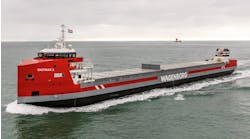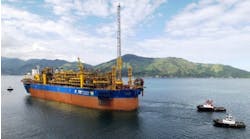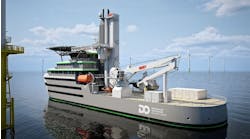Dara Williams
MCS Kenny
The push to drill in harsh, deepwater environments makes the need for an optimum riser stack-up that can maximize operability envelopes critical. This requires detailed analysis of all the stages of riser operation.
There is a requirement for more refined methods and finite element models to verify the operability of drilling riser systems in extreme conditions. Ultra deepwater and a harsh environment place higher demands on both the vessel and the drilling equipment. These higher demands result in the calculation of reduced operability envelopes for the various operations (e.g. running, hang-off, drilling, connected non-drilling, etc.).
The incorporation of an onboard riser management system (RMS) allows real-time measurement of flex-joint angles and vessel response to constantly update vessel operability curves and watch circles to reduce vessel downtime. However, before the benefits of the RMS are realized, the feasibility of the system for drilling operations must be verified. This verification involves an assessment and generation of operability envelopes and limiting environmental loading for all required operations. Traditionally these results factor a large degree of conservatism into the operability curves. However, as harsh environment and deepwater drilling become more common, these conservative assumptions result in overly conservative operability envelopes. There is a refined analysis better suited to determining operability in harsh environments.
Design considerations for optimization and operability
For deepwater harsh environment drilling, vessel options include anchored or dynamically positioned semisubmersibles, or dynamically positioned drillships. Motion characteristics of the drilling vessel determine the potential number of days lost due to unsafe conditions for drilling/running/retrieving or disconnection of the riser system itself. To perform a detailed assessment of the estimated downtime due to weather for a range of operations, the following data is required:
- Vessel response amplitude operators (RAOs)
- Well-specific operating guidelines (WSOG) specifying allowable heave, pitch, and roll values for various operations
- Seastate scatter diagrams outlining Hs/Tp combinations and occurrences on a yearly or monthly basis.
Once this data is available, a statistical assessment can produce the most probable maximum vessel heave, pitch, and roll response for all combinations of Hs and Tp. Thus, given that each seastate has an associated number of occurrences, a probability of a particular response being exceeded can be calculated. This statistical assessment of operational downtime due to extreme weather events allows the operator to rank various candidate vessels and also to track predicted vessel downtime versus actual recorded downtime.
The design and optimization of a drilling riser for harsh environments involves the assessment of a number of riser conditions and operations scenarios with variable design drivers on the riser stack-up. As a result, an iterative process is required between all stages of drilling riser analysis. The main stages to be considered are outlined below. This list is not exhaustive as each scenario may impose specific operational constraints and loads:
- Riser recoil
- Connected (drilling and non-drilling) operability
- Storm hang-off
- Deployment/retrieval
- Fatigue (wave and vortex induced vibration [VIV]).
The riser recoil analysis helps determine the loads in the riser after an emergency disconnect. The main areas of concern are to ensure that the lower marine riser package lifts clear of the BOP, that no compression is experienced in the riser or tensioners, and that the upward movement of the riser does not cause the telescopic joint to collapse. The desired output from this analysis will be the optimum riser stack-up and associated top tension in order to minimize the risk of such loads.
Connected case operability analysis determines the operability envelopes for connected drilling operations and connected non-drilling operations (e.g. waiting on weather). The critical issues include exceeding specified operating limits for tensioner stroke, upper and lower flex joint angles, wellhead and casing bending moments and stresses. The results identify the drilling riser stack-up that maximizes the connected case operability envelopes.
The storm hang-off scenario happens when the maximum connected case operating conditions are exceeded. The drilling riser stack-up must be optimized to avoid excessive stresses in the string due to bending and axial loads (driven by a combination of vessel response and large current loads) and also to avoid compression issues from vessel heave motions.
Riser deployment and retrieval impose similar loading on the string to those of the storm hang-off. The number of slicks versus buoyancy joints on the riser string and their relative location nfluence the installation and deployment operability envelopes.
When all buoyancy is concentrated within a specified region, depending on the lengths of string deployed, the actual string hanging from the vessel may have a negative wet weight, resulting in compression of the string. Or, if large numbers of slicks are deployed close to one another, the resulting installation stresses (accounting for environment and vessel loads) may be exceeded.
Wave fatigue and VIV analysis further optimizes the riser stack-up. Wave fatigue analysis identifies the fatigue-critical regions of the string. The string then can be optimized to reduce the overall damage at this location and to smooth peaks. VIV induced fatigue damage can be reduced through the use of VIV suppression devices such as fairings or strakes. However, VIV suppression devices can increased drag loading. In high current environments this leads to larger riser deflections and reduced operability. Optimum arrangement of the buoyant and slick joints within the string can reduce the effects of VIV. Placing slick joints at regular intervals between buoyant joints can disrupt current flow around the riser to help mitigate VIV.
The optimum riser stack-up can change for each scenario. One example is a stack-up optimized for recoil response, which may not result in the maximum connected case operating envelope or achieve the lowest fatigue damage. As a result, an iterative procedure is required to optimize the overall operability of the system considering all possibilities. This may require several iterations.
A design loop flowchart for harsh environment drilling riser operability, courtesy of MCS Kenny.
Determining the global dynamic response characteristics of drilling risers typically is done by a regular wave analysis methodology. The regular wave method only considers one period of response for each wave. This implies a challenge to ensure that the wave period selected does not result in an insufficiently conservative result. This issue usually is addressed by screening the system response frequencies. Once the critical system response period is identified, all wave loading is applied at this period.
In applying this methodology, it is possible that an overly conservative response will be predicted because no account is taken of the spread of wave energy over the various response frequencies within the wave spectrum.
In regions with relatively benign 1-yr and 10-yr seastates such as the Gulf of Mexico (1-yr wave Hs=16 ft [5 m], 10-yr = 19 ft [6 m]), this can give large operating envelopes despite the conservatism. However, when this method is applied to drilling riser systems in regions with considerably harsher environments where a 1-yr wave has Hs~45 ft (14 m), this can pose significant challenges in developing feasible operability envelopes for the system while connected to the well.
For example, if a standard drillship is analyzed with a regular wave methodology, the maximum vessel pitch response for a one-year storm in GoM will be approximately 4º. This will be within the allowable connected seastate limits for the vessel. If the same methodology is applied for a one-year wave in West of Shetlands, the maximum vessel pitch is calculated at approximately 10º. Based on this, it is expected that such a vessel could stay connected, at best, 85% of the time during winter. Given the increase in exploration activities in harsh environments, this traditional analysis is overly conservative and must be revised as follows.
Analytical methodology for harsh environments
Given the limit of a single critical-wave period approach, in order to account for this spread of wave energy and wave periods within the spectrum, an irregular sea modeling approach is needed. The time domain irregular sea approach however is time-consuming and can be costly. The method described here uses a large numbers of frequency domain load cases to determine the operability envelope. Once these extents are defined they are further calibrated through time domain analysis.
First, the static operating envelopes (considering only offset and current loading) are derived for the system using a suitable non-linear finite element analysis tool. Following this, a series of irregular sea analyses are performed using the frequency domain analysis module. This allows a large number of load cases to be quickly assessed. Extreme values of critical riser parameters, including flex joint angles, wellhead, and casing bending moments, are estimated by statistical extrapolation of mean and standard deviation of response.
To perform a statistical extrapolation of the system response, a probability of occurrence must be selected. For connected operations, the approach has been to select the probability corresponding to the most probable maximum value. This is based on the assumption of a single mode wave spectrum being applied in the analysis.
Following the assessment of the full load case matrix of frequency domain load cases, a set of operability envelopes are developed. As the frequency domain approach necessitates the linearization of all non-linear loads and responses, these operating envelopes must be calibrated against time domain analysis which account for the non-linear effects of soil interaction and drag loading. Thus a reduced set of critical load cases can be identified for time domain irregular sea analysis. The incorporation of the results of these time domain analysis, again using the most probable maxima of response, allows generation of the calibrated operability envelopes.
The use of the most probable maxima of system response removes much conservatism from the regular wave analysis methodology outlined earlier.
Drilling riser storm hang-off
If environmental conditions exceed the maximum allowable connected seastate, the drilling riser is disconnected from the wellhead and hung-off from the drill floor or fully retrieved until weather conditions return to acceptable limits. A full retrieval of the drilling riser increases downtime and costs as the riser must be redeployed once weather conditions return to acceptable levels. As a result, it is desirable to make a riser hang-off configuration that maximizes the operability window for storm events. The hang-off scenarios that can be enacted are as follows:
- Soft hang-off (i.e. riser hanging on tensioners)
- Hard hang-off (riser hanging from gimbal spider at drill floor)
- Specialized hang-off configuration (a combination, possibly using a specialized hang-off tool or joint).
The soft and hard hang-off options are acceptable where environmental conditions are relatively benign. In harsh environments, the operability envelopes for the storm hang-off condition are limited by large stresses in the region of hang-off and possible moonpool clashing, requiring a customized hang-off configuration that may use specialized stress joints, intermediate flex-joints, or both.
To avoid overly conservative/restrictive hang-off envelopes, an irregular wave approach is recommended. As the component loads are likely to reach limiting stress values in the storm hang-off configuration, a time domain irregular sea approach is recommended. At least five seastates under consideration are assessed. For each seastate, the maximum observed value of the critical loads from all realizations is taken as the maximum load. This is considered conservative while ensuring the spread of wave energy from the wave spectrum is applied over a range of wave periods (in contrast to the regular wave methods). Thus the irregular sea method results in wider operability envelopes.
Storm hang-off stress criteria
For the drilling riser in the disconnected (i.e. hang-off) condition, the allowable stress is defined by API RP 16Q as 67% of SMYS. This stress limitation does not consider levels of risk associated with different operations (i.e. connected versus hang-off). In addition, no distinction is made between the different stages of disconnect (i.e. transient disconnect such as recoil, riser deployment/retrieval, or survival condition such as storm hang-off).
It is argued here that the storm hang-off scenario is an extreme or survival condition so the allowable utilization of 67% is overly conservative. API RP 2RD and ISO 13628-7 both outline recommended design criteria for top tensioned riser systems (albeit production and completion/workover risers, respectively) and provide different utilizations for operating, extreme, temporary, and survival conditions.
If storm hang-off of the drilling riser is considered analogous to the extreme condition as defined by API RP 2RD, then the stress utilization factor of 80% should be acceptable for this scenario. Storm hang-off conditions and associated stress criteria for completion/workover risers (C/WOR) are outlined in ISO 13628-7. When designing to the ISO for open water C/WOR, storm hang-off conditions normally are treated as survival events with 100% yield utilization considered acceptable.
Based on the above for top tensioned riser (including drilling, C/WOR, and production) it is argued that a utilization factor corresponding to 80% of SMYS should be acceptable for the storm hang-off scenario.
Deployment/retrieval operations
A time domain irregular sea approach is recommended for these assessments. Critical issues in deployment/retrieval are compression in the riser string due to vessel heave and overbending of the string by a combination of vessel motion and current load. Moonpool clashing also can be an issue. To generate a detailed set of operability envelopes for deployment operations, a number of stages in the deployment (or retrieval) process need to be assessed (e.g. joints in splash zone, 25%, 50%, 75%, and 100% of joints deployed). In addition, if deployment operations may be suspended and a given length of string hung-off from the vessel, the effects of VIV, especially in high currents, need to be considered.
Many fifth and sixth generation drilling vessels are dual-activity rigs. On these vessels, simultaneous running of both riser and casing or conductor is possible. If simultaneous running of strings from the main and auxiliary well centers is to be carried out, a detailed installation analysis is required to determine the operational envelopes of the system.
The main issues to consider are stresses within the strings due to wave and current loading, clashing between adjacent strings, and clashing of strings with the vessel structure or moonpool walls. The generation of these operability curves requires the assessment of a number of combinations of string types and strings of varying length.
The deployment and retrieval analysis also identifies the maximum allowable current loading on the riser (or conductor or casing) during deployment. In the event currents exceed these values, the operator can determine required vessel speeds for deployment while drifting with current. In addition, the limiting current values can be used to determine optimum vessel speeds for well hop or transit operations with lengths of riser/conductor/casing deployed in the moonpool.
Editor’s note: The preceding article is an abridged version of a presentation made at PennWell’s Deep Offshore Technology (DOT) conference in Monaco, in December 2009.





